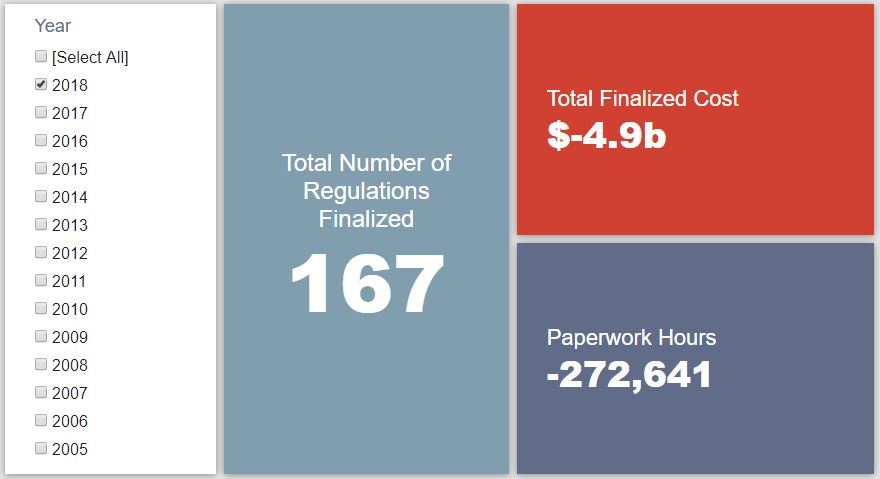Week in Regulation
July 30, 2018
A $3 Billion Week
Sometimes one rulemaking can make all the difference. A proposed rule from the Centers for Medicare and Medicaid Services (CMS) was all it took to shake up an otherwise incredibly quiet week. Between both proposed and final rules, agencies published roughly $3.3 billion in net costs, but cut 544,248 hours of paperwork. The per capita regulatory burden for 2018 is negative $15.04.
Regulatory Toplines
- New Proposed Rules: 39
- New Final Rules: 55
- 2018 Total Pages of Regulation: 36,159
- 2018 Final Rules: -$4.9 Billion
- 2018 Proposed Rules: $12.9 Billion
The most noteworthy rulemaking of the week was the CMS proposal on “Revisions to Payment Policies Under the Physician Fee Schedule and Other Revisions to Part B for CY 2019.” These rules are generally rather long, but mundane, transfer payment directives produced each year. However, in the Executive Order (EO) 13,771 section for this one, CMS notes that: “The estimated impact would be $5 million in costs in 2019, $4.114 billion in costs in 2020, and $44 million in cost savings in 2021 and thereafter.” Per a supporting document in the rulemaking docket, the 20-year total cost of the program comes down to $3.3 billion due to the annual savings kicking in from 2021 onward. For comparison, the six other rulemakings from last week that had some quantified cost estimate combined for a grand total of $2.28 million in net costs.
Tracking Regulatory Modernization
According to AAF analysis, since the start of FY 2018 (beginning Oct. 1, 2017), executive agencies have promulgated 46 deregulatory actions with quantified estimates against 10 regulatory measures, under the rubric created by EO 13,771 and the administration’s subsequent guidance document on the matter. These rules combine for net annual savings of roughly $1.3 billion. This means that agencies have thus far surpassed the administration’s cumulative goal for FY 2018 of $687 million in net annual savings. In fact, according to the administration’s latest Unified Agenda, agencies are on track to roughly double that goal.
Click here to view AAF’s examination of the administration’s progress under the “one-in, two-out” executive order through the end of Fiscal Year 2017.
State of Major Obama-Era Initiatives
Based on total lifetime costs of the regulations, the Affordable Care Act has imposed costs of $52.9 billion in final state and private-sector burdens and 176.9 million annual paperwork hours.
Since passage, the Dodd-Frank financial reform legislation has produced more than 82.9 million final paperwork burden hours and imposed $38.9 billion in direct compliance costs.
Total Burdens
Since January 1, the federal government has published $8 billion in net costs (despite $4.9 billion in net savings from final rules) and paperwork burdens amounting to 927,568 hours (including 272,641 hours of paperwork reduced under final rules). Click here for the latest Reg Rodeo findings.











